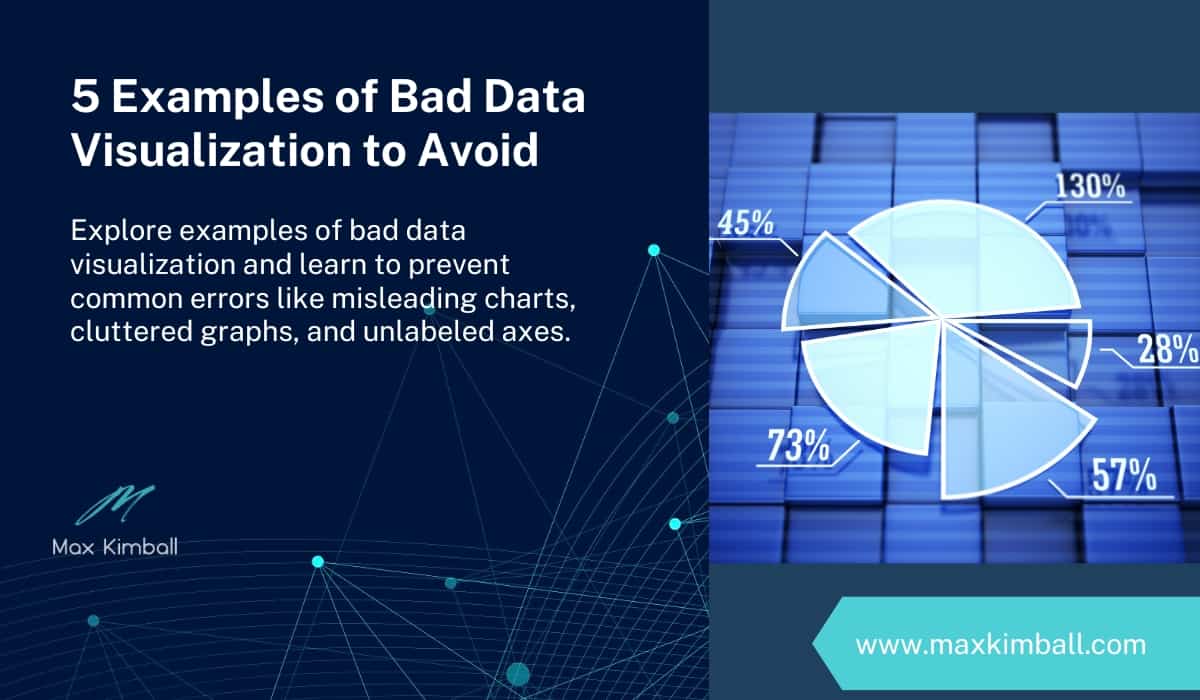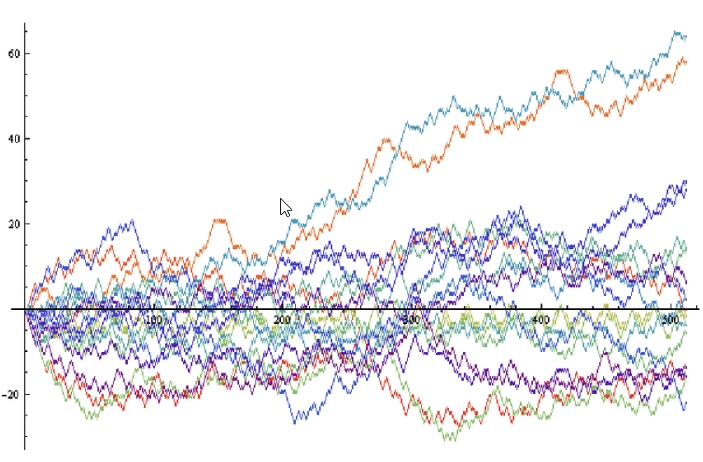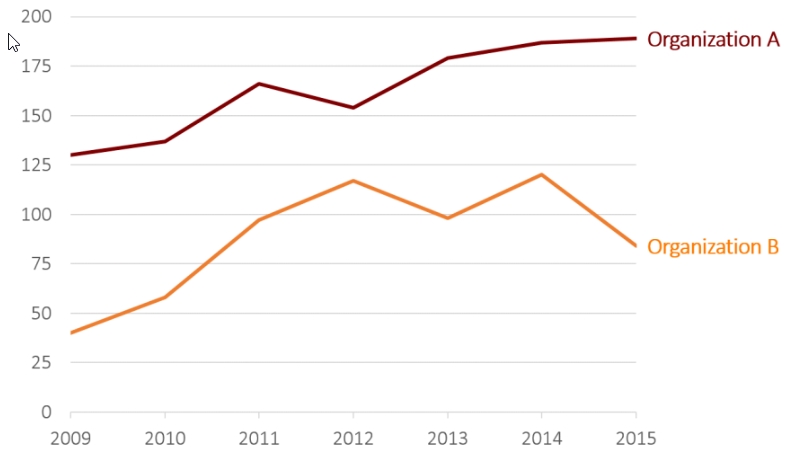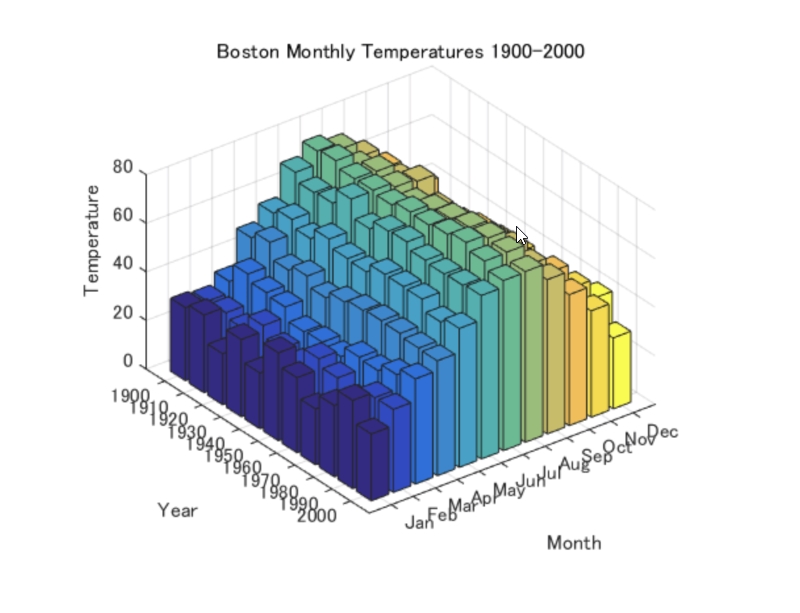5 Examples of Bad Data Visualization to Avoid

In the world of data analysis, examples of bad data visualization can lead to incorrect interpretations and misguided decision-making. As a data analyst, it is crucial to recognize and avoid these pitfalls when presenting your findings. In this blog post, we will delve into some common mistakes that result in misleading or confusing visual representations.
From the deceptive nature of certain pie charts to overly complex graphs that obscure valuable insights, you’ll learn how to identify these issues in order to create more effective visualizations. We will also discuss the importance of properly labeled axes, as well as why 3D visualizations often do more harm than good.
Lastly, we’ll explore cluttered visualizations that make it difficult for viewers to discern patterns or trends within the data points presented. By understanding these examples of bad data visualization and their potential impact on your work, you can enhance your skills as a professional analyst and ensure clear communication through accurate graphical representation.
Table of Contents:
- Misleading Pie Charts
- How to Improve Pie Charts:
- Overly Complex Graphs
- Unlabeled Axes
- 3D Visualizations
- Cluttered Visualizations
- Frequently Asked Questions Examples of Bad Data Visualization
- Conclusion
1. Misleading Pie Charts
Pie charts are a popular choice for visualizing data, but they can often lead to misleading data visualization examples. The main issue with pie charts is that it’s difficult to accurately compare the size of different slices, especially when there are many categories or the differences between them are small. Inaccurate analysis of the data may result from using pie charts, potentially leading to misguided decisions.
A better alternative to pie charts is bar charts, which allow for easier comparison between categories and provide a clearer representation of the values. Bar charts also make it simpler to include additional information such as labels or percentages without cluttering up the visualization.

How to Improve Pie Charts:
- Limit Categories: Reduce the number of categories displayed in your chart by grouping similar items together or focusing on only the most important ones.
- Add Labels: Clearly label each slice with its corresponding category name and percentage value so viewers can easily understand what each piece represents.
- Avoid Overlapping Slices: Make sure no two slices overlap, as this will make it even more challenging for users to interpret your chart correctly.
- Show Data Points: Include actual data points alongside your chart so readers have access to precise numbers if needed.
In summary, pie charts may appear simple and straightforward but can often be ineffective when it comes to effectively conveying data; thus, by adhering to best practices for creating accurate visualizations, one can ensure their data is properly presented. By considering these common mistakes and implementing best practices for creating clear and accurate visualizations, you’ll be able to avoid misleading data visualizations and make better use of your data visualization tools.
Misleading Pie Charts can be incredibly deceiving, and it is important to always check the underlying data before drawing conclusions. Moving on, overly complex graphs can also lead to confusion or misinterpretation of data.
2. Overly Complex Graphs
Overly complex graphs are one of the most common bad data visualization examples. These visuals can be characterized by a high perplexity and increased randomness, with too many variables, colors or chart types that make it hard for viewers to comprehend the data. In some cases, these complexities may even lead to misleading data visualizations, as they can obscure important trends or relationships within the data.
A prime example of an overly complex graph is a line chart with multiple lines representing different categories but without any clear distinction between them. This type of visualization makes it challenging for viewers to differentiate between various categories and analyze their respective trends over time accurately.

The Alternative: Simplify Your Visualizations
To avoid creating overly complex graphs, follow these best practices:
- Select fewer variables: Limit your visualization to only include essential data points that contribute meaningfully to your analysis.
- Create separate charts: If you need to present multiple datasets in a single view, consider using small multiples or panel charts instead of cramming everything into one graph.
- Maintain consistency in design elements: Use consistent colors, symbols, and labels across all components of your visualization so that viewers can easily identify patterns and compare values at a glance.
- Avoid unnecessary embellishments: Remove any decorative elements such as background images or excessive gridlines that do not add value to your presentation and may distract from the actual data content.
In summary, simplifying your visualizations will help ensure clarity when presenting data while reducing potential confusion among viewers. Adhering to principles of data visualization can make it easier for viewers to gain insights from your analysis, creating a more effective and captivating representation.
For further guidance on creating clear and concise visualizations, check out these data visualization tips or explore some popular data visualization tools.
Overall, overly complex graphs can be difficult to interpret and should be avoided when possible. Moving on, we will look at unlabeled axes and how they can impede data visualization.
Overly complex graphs are a common example of bad data visualization, as they can obscure important trends and relationships within the data. To avoid this issue, it’s best to limit your visualization to essential data points, use consistent design elements, and remove any unnecessary embellishments. Simplifying your visualizations will help ensure clarity when presenting data while reducing potential confusion among viewers.
3. Unlabeled Axes
One of the most common data visualization mistakes is leaving axes unlabeled or poorly labeled. This can lead to confusion and misinterpretation of the data, as viewers may not understand what each axis represents or how they should interpret the information presented in the graph.
An example of a misleading data visualization with unlabeled axes would be a line chart showing two lines representing different variables over time but without any indication of which variable corresponds to which line, or even what units are being used on either axis. In this case, it becomes nearly impossible for someone viewing the chart to accurately compare and contrast these variables.

The Importance of Properly Labeled Axes
- Clarity: Clearly labeling your axes ensures that your audience understands exactly what they’re looking at when examining your visual representation.
- Ease of interpretation: Proper labels make it easier for people to quickly grasp trends and patterns within your data sets without having to spend excessive amounts of time deciphering unclear charts.
- Avoiding misinformation: Misleading data visualizations can result from unlabeled axes if readers make incorrect assumptions about what’s being represented. By properly labeling all aspects of your graphs, you minimize this risk and promote accurate understanding among viewers.
Better Solution: Label Your Axes Clearly & Concisely
To avoid creating bad data visualizations due to unlabeled axes, always ensure that both horizontal (x-axis) and vertical (y-axis) components are clearly labeled with appropriate titles describing their respective contents. Additionally, include units where necessary so that viewers have context for interpreting numerical values within your charts effectively.
If space constraints limit your ability to include axis labels directly on the graph, consider using a legend or key to provide necessary information about each data point. By adhering to these guidelines, you can ensure a clear and tidy visual representation while still enabling your viewers to comprehend the data.
By following these best practices for labeling axes in data visualization tools, you’ll create more effective and informative visuals that enhance your overall business intelligence efforts and help drive better decision-making within your organization.
Interpreting data visualizations without labeled axes can be an extremely perplexing and unpredictable task, making it difficult to accurately comprehend the information being presented. Creating 3D visuals necessitates additional considerations to make them successful.
Leaving axes unlabeled or poorly labeled is a common data visualization mistake that can lead to confusion and misinterpretation of the data. Properly labeling all aspects of your graphs promotes accurate understanding among viewers, avoids misinformation, and makes it easier for people to quickly grasp trends and patterns within your data sets without having to spend excessive amounts of time deciphering unclear charts.
4. 3D Visualizations
While they may appear visually appealing, 3D visualizations are often not the best choice for data analysis. However, 3D graphics can obscure data points and impede accurate interpretation of the presented information. In some cases, 3D visuals can lead to misinterpretations or even erroneous results due to their complexity and distraction.
The Problem with 3D Visuals
One common issue with 3D visuals is that they introduce a third axis which adds complexity and makes it harder for viewers to focus on relevant details. This additional dimension can also create an illusion of depth, making certain elements seem more prominent than others when in reality their values might be similar or identical.
A classic example of misleading 3D visualization is a bar chart. When displayed in three dimensions, bars closer to the front may appear larger than those further back due to perspective distortion – even if their actual heights are equal. This skewed perception could cause users to misinterpret important trends or patterns within the dataset.

An Alternative: Simplify with 2D Graphics
To avoid these issues and present your data more effectively, consider using two-dimensional (2D) graphics instead. For instance, replacing a complex 3D bar chart with its simpler counterpart – a standard flat bar chart – will allow readers to easily compare individual values without any unnecessary distractions caused by extraneous dimensions:
- Easier interpretation: By eliminating depth from your visualization tools, you’ll enable viewers to quickly grasp key insights and relationships between different variables within your dataset.
- Reduced risk of misinterpretation: Flat visuals minimize the potential for distortion, ensuring that data points are accurately represented and minimizing the chance of misleading conclusions.
- Better focus on important details: Simplified graphics allow users to concentrate on relevant information without being overwhelmed by unnecessary visual elements.
In summary, while 3D visualizations may seem attractive at first glance, they can often lead to confusion or even incorrect interpretations. By opting for simpler 2D alternatives – such as flat bar charts or line graphs – you’ll ensure your audience has a clear understanding of the data you’re presenting and can make informed decisions based on accurate insights.
Tips for Effective Data Visualization
To further improve your skills in creating good data visualization, consider following these best practices:
- Select appropriate chart types based on your dataset’s characteristics and objectives.
- Avoid cluttering your visuals with too many colors or design elements; keep it clean and simple so viewers can easily interpret the information presented.
- Always label axes clearly and provide legends when necessary to avoid ambiguity in interpreting results.
Taking these steps will help ensure that your visualizations not only look professional but also effectively communicate key findings from complex datasets – ultimately enhancing both their value and impact within business intelligence contexts. Learn more about effective data visualization techniques here.
Interpreting 3D visualizations can be a challenge, so it’s essential that analysts and learners grasp the boundaries of this kind of representation. Cluttered visualizations are another common mistake that should be avoided in order to effectively communicate information through data visualization.
3D visualizations may look attractive, but they can distort data and lead to misleading conclusions. To avoid this issue, it is recommended to use simpler 2D graphics such as flat bar charts or line graphs for easier interpretation, reduced risk of misinterpretation, and better focus on important details. Additionally, effective data visualization requires appropriate chart types selection based on dataset characteristics and objectives while avoiding cluttering visuals with too many colors or design elements.
5. Cluttered Visualizations
Cluttered visualizations are another common issue in bad data visualization examples. When too much information is crammed into a single chart or graph, it becomes difficult for the audience to understand and interpret the data points accurately. This can lead to confusion and misinterpretation of the presented data.
A cluttered visualization may include overlapping labels, multiple colors that don’t add value, unnecessary gridlines, or an excessive number of data series on a single chart. These elements make it challenging for viewers to focus on the key insights and trends within the data visualization.

Tips for decluttering your visualizations:
- Simplify your design: Remove any unnecessary elements such as gridlines, background shading, or borders that do not contribute to understanding the data.
- Leverage white space: Ensure there is enough space between different sections of your charts and graphs so they are easy to read.
- Select appropriate colors: Use color sparingly and purposefully; avoid using too many bright or contrasting colors that can distract from important information.
- Avoid overcrowding with text: Keep labels concise while still providing context for readers; consider using legends if necessary.
- Create separate charts when needed: If you have multiple datasets that cannot be easily combined into one clear chart without causing confusion,, create separate visual representations instead.
Exemplifying the issue of overcrowding, let’s examine a graph that is crammed with data points, an array of hues and jumbled tags. The original visualization has multiple data series, numerous colors, and overlapping labels:
By simplifying the design, removing unnecessary elements, and focusing on a single data series per chart, we can create a much cleaner and more effective visualization:
In conclusion,, cluttered visualizations are one of the most common mistakes in bad data visualizations. By following best practices for presenting data clearly and concisely,, you can avoid this pitfall and ensure your audience gains valuable insights from your work.
Cluttered visualizations are a common issue in bad data visualization examples. Simplifying the design, leveraging white space, selecting appropriate colors, avoiding overcrowding with text, and creating separate charts when needed can help to avoid this pitfall and ensure your audience gains valuable insights from your work.
Frequently Asked Questions Examples of Bad Data Visualization
What is an example of bad data visualization?
An example of bad data visualization is one that misrepresents the underlying data, such as using truncated bar charts or pie charts with incorrect proportions. This can lead to confusion and misinterpretation by the audience. It’s important for visualizations to accurately represent the information they are meant to convey.
What is a real-world example of misleading data visualization?
A real-world example of misleading data visualization occurred during the 2016 US Presidential Election when some media outlets used truncated bar graphs comparing poll results, which exaggerated differences between candidates’ percentages. This led viewers to perceive larger gaps in support than actually existed.
What are the 4 types of bad data visualizations?
The four types of bad data visualizations include:
1. Misleading representations (e.g., truncated bars, distorted scales)
2. Overly complex graphs (e.g., excessive use of colors or elements)
3. Lack of clarity (e.g., unlabeled axes, missing legends)
4. Inappropriate formats (e.g., 3D visuals for two-dimensional comparisons)
What are the negative effects of poor data visualization?
Poor data visualization can lead to misinformation, confusion among audiences, and ultimately flawed decision-making based on inaccurate interpretations. Misrepresenting crucial information through unclear or deceptive visuals undermines trust in both the presented analysis and its source.
Conclusion
In conclusion, bad data visualization can be misleading and confusing. Pie charts without clear labels or overly complex graphs can distort the data being presented. 3D visualizations and cluttered visualizations can also make it difficult to interpret the information being conveyed.
It’s important for data analysts to use good data visualization practices when presenting their findings. By avoiding common mistakes like those listed above, they can ensure that their audience understands the information accurately and effectively.
If you’re looking for help with your own data analysis projects, visit Max Kimball today!







4 Comments
Comments are closed.